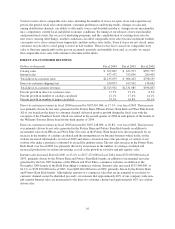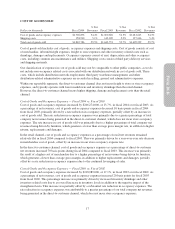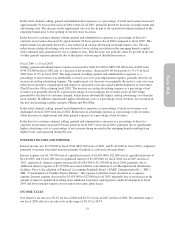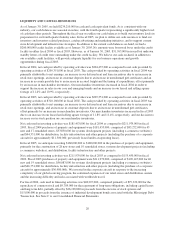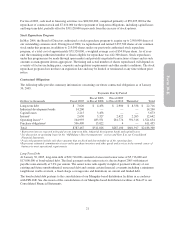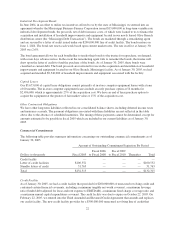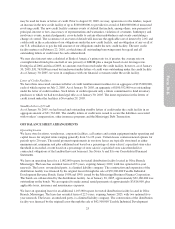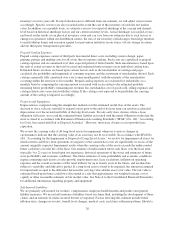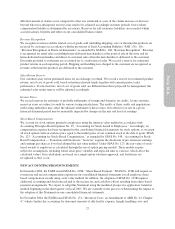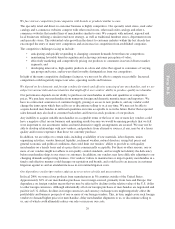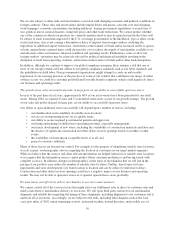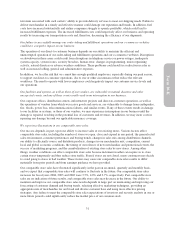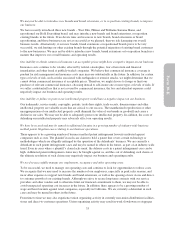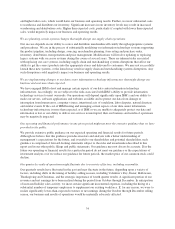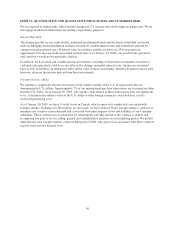Pottery Barn 2004 Annual Report Download - page 33
Download and view the complete annual report
Please find page 33 of the 2004 Pottery Barn annual report below. You can navigate through the pages in the report by either clicking on the pages listed below, or by using the keyword search tool below to find specific information within the annual report.inventory over two years old. If actual obsolescence is different from our estimate, we will adjust our provision
accordingly. Specific reserves are also recorded in the event the cost of the inventory exceeds the fair market
value. In addition, on a monthly basis, we estimate a reserve for expected shrinkage at the concept and channel
level based on historical shrinkage factors and our current inventory levels. Actual shrinkage is recorded at year-
end based on the results of our physical inventory count and can vary from our estimates due to such factors as
changes in operations within our distribution centers, the mix of our inventory (which ranges from large furniture
to small tabletop items) and execution against loss prevention initiatives in our stores, off-site storage locations,
and our third party transportation providers.
Prepaid Catalog Expenses
Prepaid catalog expenses consist of third party incremental direct costs, including creative design, paper,
printing, postage and mailing costs for all of our direct response catalogs. Such costs are capitalized as prepaid
catalog expenses and are amortized over their expected period of future benefit. Such amortization is based upon
the ratio of actual revenues to the total of actual and estimated future revenues on an individual catalog basis.
Estimated future revenues are based upon various factors such as the total number of catalogs and pages
circulated, the probability and magnitude of consumer response and the assortment of merchandise offered. Each
catalog is generally fully amortized over a six to nine month period, with the majority of the amortization
occurring within the first four to five months. Prepaid catalog expenses are evaluated for realizability on a
monthly basis by comparing the carrying amount associated with each catalog to the estimated probable
remaining future profitability (remaining net revenues less merchandise cost of goods sold, selling expenses and
catalog related-costs) associated with that catalog. If the catalog is not expected to be profitable, the carrying
amount of the catalog is impaired accordingly.
Property and Equipment
Depreciation is computed using the straight-line method over the estimated useful lives of the assets. The
decision to close, relocate, remodel or expand a store prior to the end of its lease term can result in accelerated
depreciation over the revised useful life of the long-lived assets. For any early store closures where a lease
obligation still exists, we record the estimated future liability associated with the rental obligation on the date the
store is closed in accordance with Statement of Financial Accounting Standards (“SFAS”) No. 146, “Accounting
for Costs Associated with Exit or Disposal Activities.” However, most store closures occur upon the lease
expiration.
We review the carrying value of all long-lived assets for impairment whenever events or changes in
circumstances indicate that the carrying value of an asset may not be recoverable. In accordance with SFAS No.
144, “Accounting for the Impairment or Disposal of Long-Lived Assets,” we review for impairment all stores for
which current cash flows from operations are negative or the construction costs are significantly in excess of the
amount originally expected. Impairment results when the carrying value of the assets exceeds the undiscounted
future cash flows over the life of the lease. Our estimate of undiscounted future cash flows over the lease term
(typically 5 to 22 years) is based upon our experience, historical operations of the stores and estimates of future
store profitability and economic conditions. The future estimates of store profitability and economic conditions
require estimating such factors as sales growth, employment rates, lease escalations, inflation on operating
expenses and the overall economics of the retail industry for up to twenty years in the future, and are therefore
subject to variability and difficult to predict. If a long-lived asset is found to be impaired, the amount recognized
for impairment is equal to the difference between the carrying value and the asset’s fair value. The fair value is
estimated based upon future cash flows (discounted at a rate that approximates our weighted average cost of
capital) or other reasonable estimates of fair market value. See Note A to the Consolidated Financial Statements
for additional information regarding property and equipment.
Self-Insured Liabilities
We are primarily self-insured for workers’ compensation, employee health benefits and product and general
liability insurance. We record self-insurance liabilities based on claims filed, including the development of those
claims, and an estimate of claims incurred but not yet reported. Factors affecting this estimate include future
inflation rates, changes in severity, benefit level changes, medical costs, and claim settlement patterns. Should a
26


